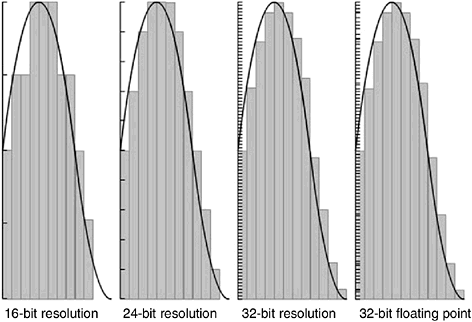About 32-bit Recording
| [ LiB ] |
About 32-bit Recording
Most audio hardware available today supports 16-bit resolution. Some better quality sound cards also support 20- and 24-bit resolutions . With the 16-bit resolution (see Figure 1.16), the vertical steps corresponding to voltage values are few and far apart. In the 24-bit resolution, there are many more steps (also called Quantum ) than in 16-bit recordings. In the 32-bit, the binary word is twice as long, but as you will see in the Table 1.1, instead of having 65,535 steps, you have more than four billion steps. Finally, in 32-bit floating-point resolution, you still have more than four billion steps; however, they are not fixed but variable points that adjust themselves according to the needs of the audio waveform. This dramatically increases the dynamic range (range between the loudest sound before digital clipping and softest audible sound) of a digital audio recording. On the minus side, it also increases the hard disk space needed to record digital audio as well as processing time when applying changes, such as adding an effect to a sound. Ultimately, to record using precisions higher than 24-bit resolutions, you'll need a fast computer, fast hard drive, and lots of memory, both in disk space and in RAM.
Figure 1.16. Understanding the importance of bit resolution in digital audio recording.

Table 1.1 illustrates the different values that can be stored in their respective resolutions:
Table 1.1. Minimum and Maximum values for 16-, 24- and 32-bit resolution audio signal
| Resolution | Minimum Value | Maximum Value | Dynamic Range | Hard Disk Space (min/mono) |
|---|---|---|---|---|
| 16-bit | -32,768 | 32,767 | 96 dBFS | 5,168 KB |
| 24-bit | -8,388,608 | 8,388,607 | 144 dBFS | 7,752 KB |
| 32-bit | -2,147,483,648 | 2,147,483,647 | 193 dBFS | 10,336 KB |
Recording audio up until now was limited to fixed integer values, as mentioned previously. With floating point, the computer adds a decimal value and can move that decimal point wherever it needs it in order to get greater precision. Here's an example: Let's say you have an analog signal coming in at 1.2245 volts . If you have a system that provides only two decimal points, your resulting value would be 1.23 or 1.22. In both cases, this would not be very precise, but it's as precise as the recording system could be. Floating point technology simply adds a decimal value (up to seven) as needed, making the recorded value exactly 1.2245. This kind of technology yields a dynamic range of almost 200 dB! This dynamic range means that you can drive your guitar without ever worrying about digital clipping. You should still be careful, though, because while there might not be digital clipping in your signal, you might still have digital distortion, which sounds like analog distortion. And, any way you look at it, unwanted distortion/noise is never a good thing.
Remember that the bit depth (resolution) of the mixdown does not have to be the same as the recorded tracks. Cubase allows you to select a different format to mix down your tracks when you are finished working on them. This process happens because Cubase records in a format that is superior to the quality available on regular CD players. So, a good rule of thumb to follow is always work with the best quality your entire system supports (all devices involved in the recording process especially ), saving the downgrading for the last step before burning to CD. If your hardware and software can handle it, go for it. But remember this: Audio CD format supports only 44.1 kHz, 16-bit stereo files. So, if you don't convert your audio beforehand, you won't be able to write it in audio CD format.
Do I Have the Right Hardware?
To use 24-bit or 32-bit recording, you need to have a 24-bit compatible sound card to actually have better quality sound. Recording in 24-bit or 32-bit with a 16-bit sound card will only make your file larger; it will not give you better results. Not to mention that your 16-bit sound card might not even be able to play back the audio recorded at 24-bit. This said, you have to understand that 24-bit recordings take up 1.5 times as much space as a 16-bit recording, and that 32-bit recordings take up twice the space of a 16-bit recording and make more demands on the CPU and hard disk performance of your computer. The kind of hard disk and RAM you have in your computer will greatly influence the performance of your system when using 24- or 32-bit recording.
| [ LiB ] |